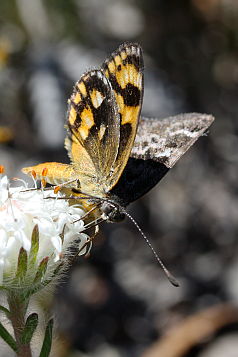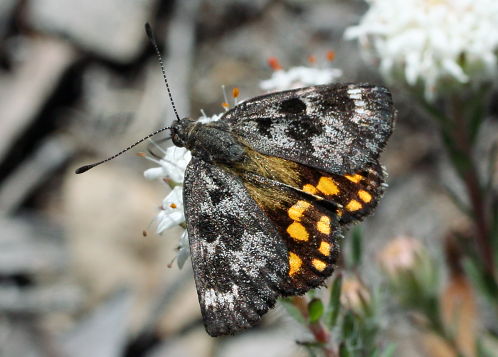Western Australia’s Wheatbelt
Overview
Western Australia’s Wheatbelt region extends across much of the semi-arid inland areas of south-western Australia east of the Darling Scarp. Once covered in vast expanses of Eucalyptus woodland, clearing of much of the native vegetation for agriculture and mining has seen a dramatic decline of the region’s rich biodiversity throughout the twentieth century. As a result, a significant fraction of the Wheatbelt’s native plants and animals are now under serious threat of extinction, with taxa such as Williams’ Spider Orchid (Caladenia williamsiae) or the Arid Bronze Azure (Ogyris subterrestris subsp. petrina) currently known from just a single location.
Despite these threats, significant patches of native vegetation can still be found across the Wheatbelt, including the vast Wandoo woodlands along the western edge of the Wheatbelt and areas of native scrub in the more arid eastern parts of the region. These are home to some of the region’s most iconic plant and animal species, including a large number of terrestrial orchids and numerous reptiles.
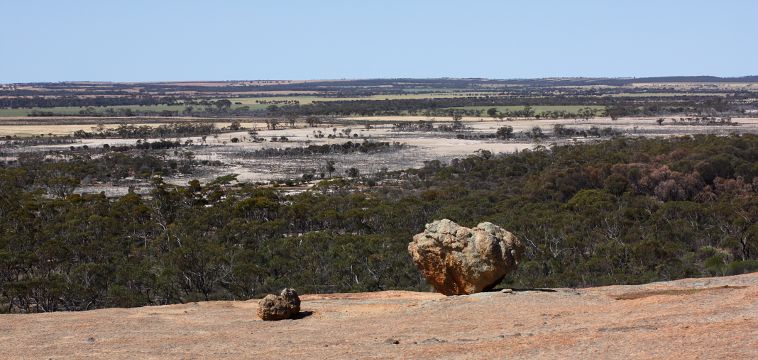
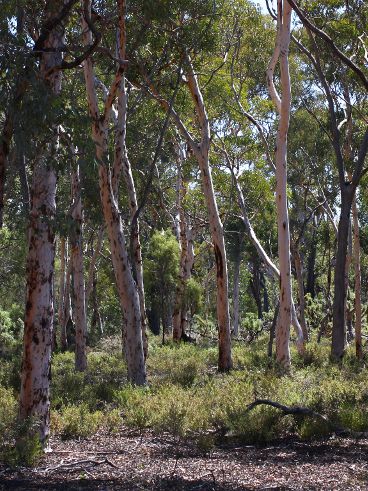
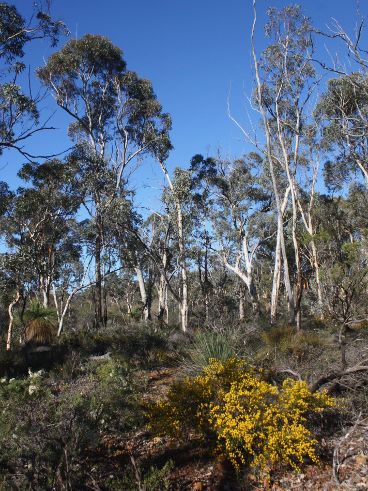
Throughout the Wheatbelt there are granite rocks of various sizes and shapes which are home to a highly specialised community of plants. They benefit from excess rainwater runoff that accumulates in soil pockets on the rock itself as well as in low-lying areas around the base of the rock. This provides enough moisture to support a large diversity of plants, including a numerous orchid species. One of the largest and most famous granite rocks is Wave Rock near the town of Hyden in the eastern Wheatbelt. Erosion by water is believed to have created its characteristic wave-like shape, and in seasons of good winter rainfall the area surrounding the rock will burst into colour from a dense carpet of wildflowers.
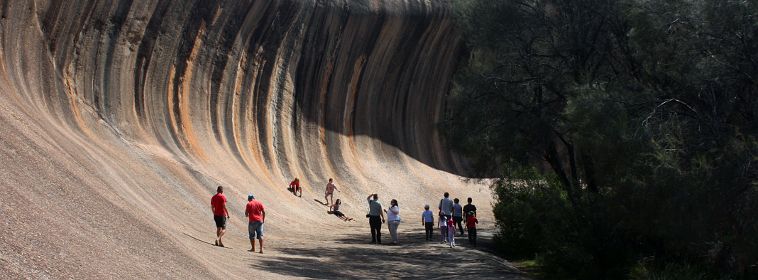
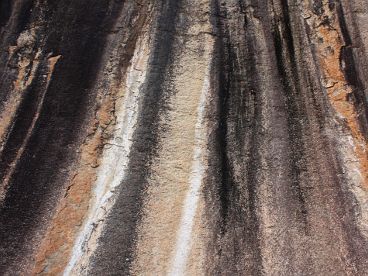
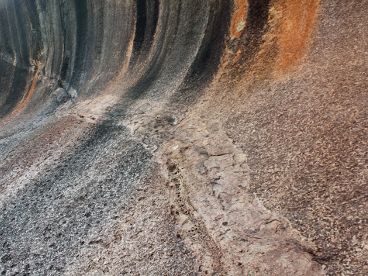
Another unique habitat of the Wheatbelt are salt lakes. While usually dry throughout most of the year, they can fill up with water in seasons of good winter rainfall, creating a rich habitat for waterbirds and native plants. Salt lakes are among the most threatened habitats of the Wheatbelt, as changing water tables and increasing salinity caused by agricultural land use are having a negative impact on the plant and animal communities associated with the lakes.
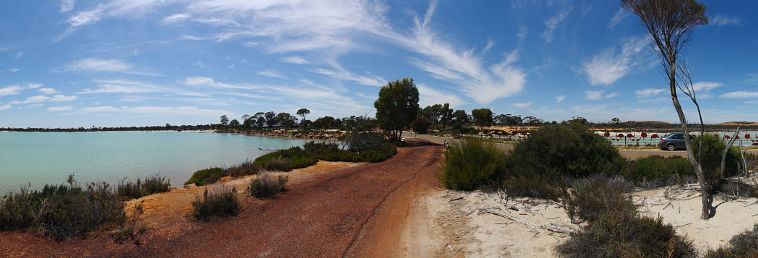
Orchids
The Wheatbelt is famous for its large number of colourful species of orchid, most of which emerge during late winter and early spring. Among the most spectacular orchids are numerous species of Wispy Spider Orchid (Caladenia) characterised by their long, narrow petals and sepals. A characteristic and common species of the Wandoo woodlands of the western Wheatbelt is the Blood Spider Orchid (Caladenia filifera) named after the red colour of its flowers. Another beautiful species found across the western Wheatbelt is the Primrose Spider Orchid (Caladenia xantha) which also grows in Wandoo woodland and is locally common. Joseph’s Spider Orchid (Caladenia polychroma) can be found across the southern Wheatbelt and comes in a wide range of different colours ranging from white to dark red. Another characteristic species is the Brookton Highway Spider Orchid (Caladenia fluvialis) which was only recently described and occurs in winter-wet flats and along seasonal creeks in the western Wheatbelt.
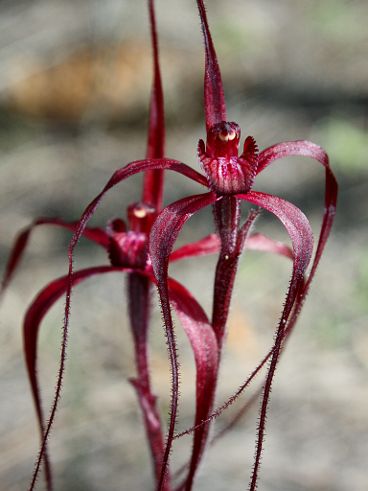
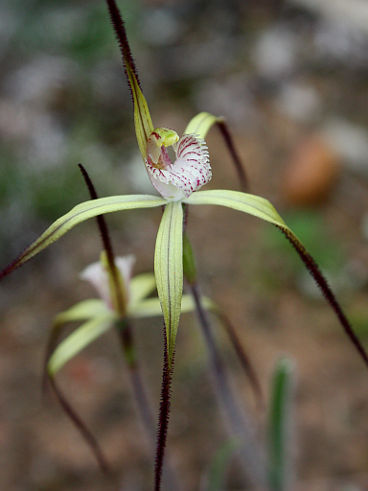
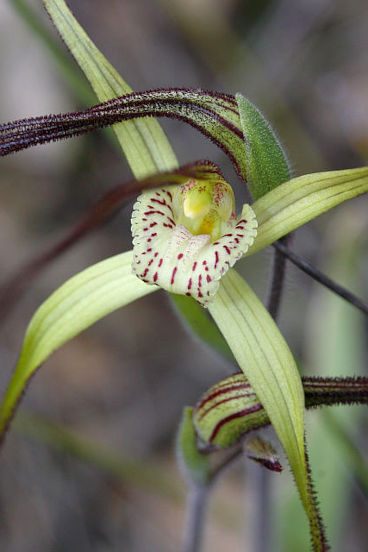
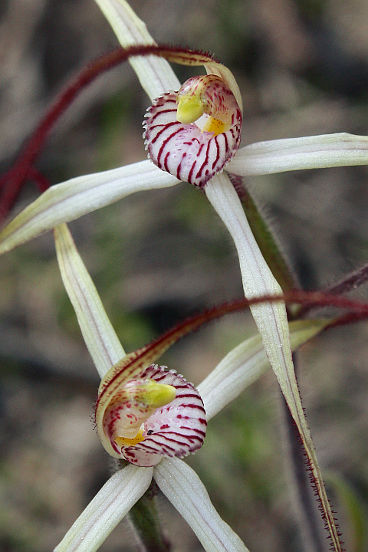
Many of the Wheatbelt’s Wispy Spider Orchids look rather similar and are notoriously difficult to tell apart. One of these is Talbot’s Spider Orchid (Caladenia pendens subsp. talbotii), a subspecies of the Pendant Spider Orchid (Caladenia pendens) that is restricted to a small area of the western Wheatbelt and is easily confused with many of the other (sub-)species of white Wispy Spider Orchids, e.g. the Common Spider Orchid (Caladenia vulgata) or the Noble Spider Orchid (Caladenia nobilis). Others, such as Chapman’s Spider Orchid (Caladenia chapmanii), are fairly distinct and not too difficult to identify.
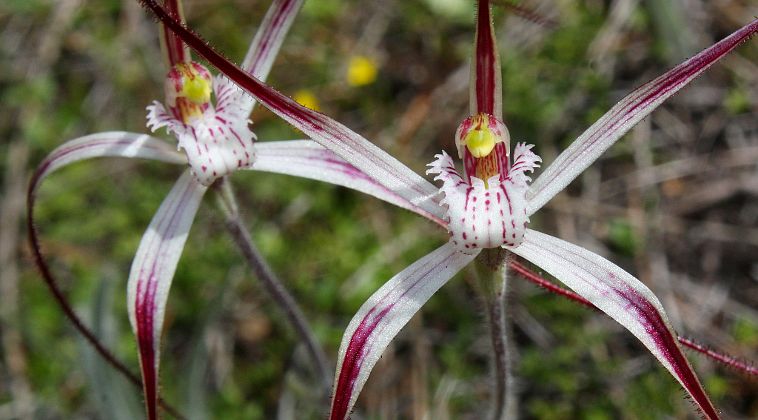
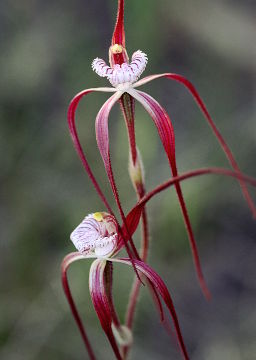
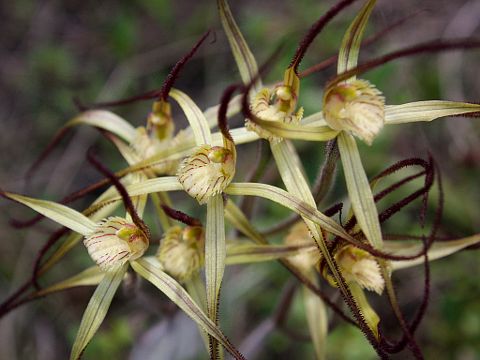
Another common Wispy Spider Orchid of the Wheatbelt region is the aptly named Chameleon Spider Orchid (Caladenia dimidia). Its common English name alludes to the highly variable colour of the flowers. The Chameleon Spider Orchid is found across the eastern Wheatbelt and is locally common in suitable habitats where it often forms spectacular clumps.
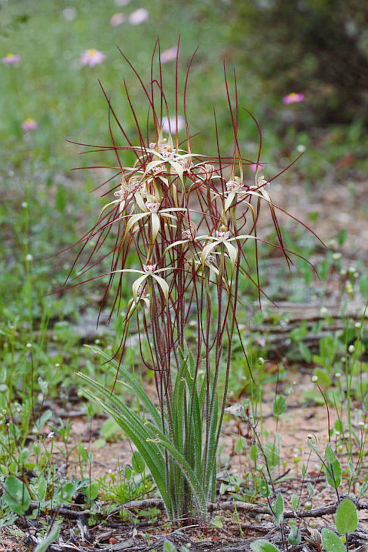
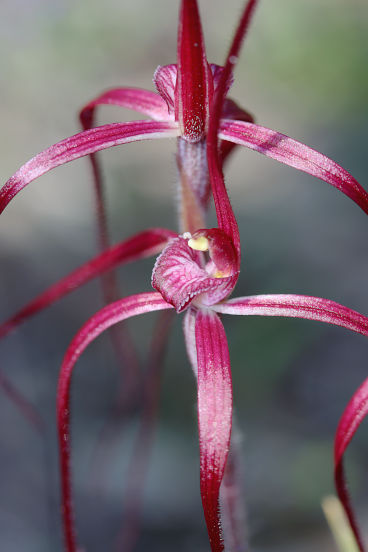
In addition to the Wispy Spider Orchids, several other species of Spider Orchid are found throughout the Wheatbelt. A particularly spectacular one is the Fringed Mantis Orchid (Caladenia falcata) with its strangely upwards-pointing sepals and colourful, broad labellum. It can be found across most of the Wheatbelt in a variety of habitats and is generally abundant. A very similar, but more restricted and uncommon species, is the Smooth-lipped Spider Orchid (Caladenia integra), which grows in the vicinity of granite outcrops and is easily identified by the smooth edges to its labellum.
One of the most common and widespread orchids of the central and eastern Wheatbelt is the Clown Orchid (Caladenia roei), also known as Jack-in-the-box. Its common name is a reference to its colourful flowers that resemble a stick figure with stretched-out arms. It grows in a variety of habitats and is particularly abundant in winter-wet areas and around granite outcrops, although it can be difficult to find due to its rather small size. Another common species is the Clubbed Spider Orchid (Caladenia longiclavata) which was named after its prominently clubbed petals and sepals and can be found in forests and woodlands along the western edge of the Wheatbelt.
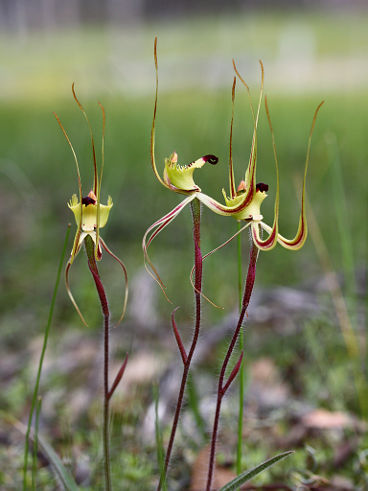
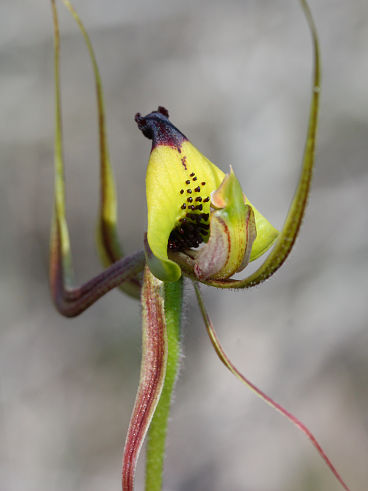
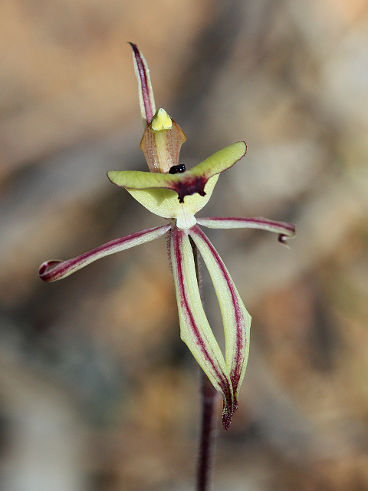
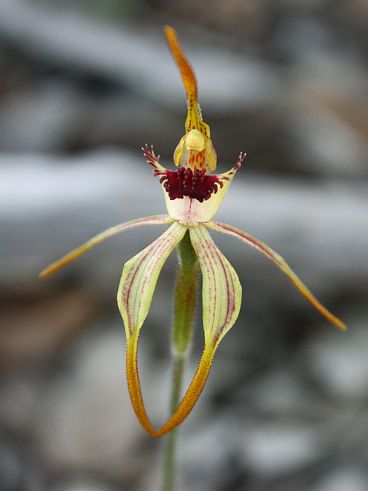
One of the most unusual orchids of the Wheatbelt is the Winter Spider Orchid (Caladenia drummondii). Unlike all other Spider Orchids of Western Australia, it flowers in late autumn at a time when its habitat is still very dry and there is little other vegetation around. Winter Spider Orchids typically grow in dry Mallee woodland and can be found across the central and western Wheatbelt. Due to their small size and dull colouration they are difficult to locate in the dry leaf litter, although they are locally abundant and often occur in small groups or clumps.
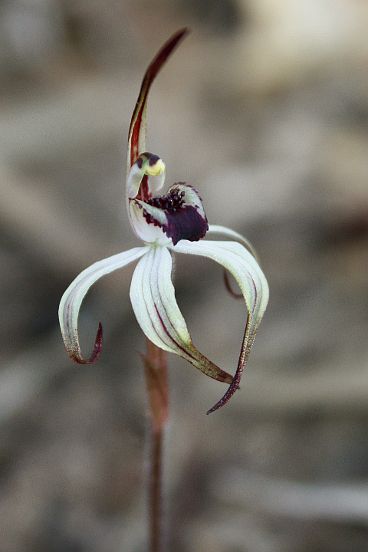
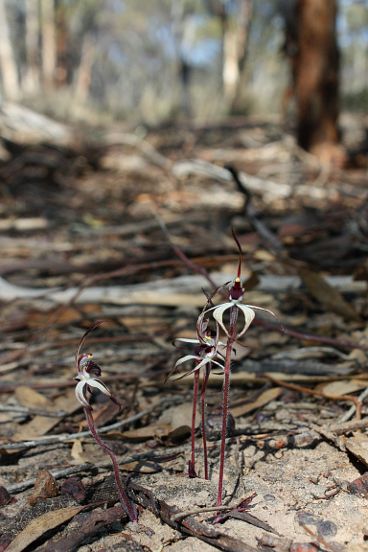
As a result of clearing of much of the Wheatbelt’s original vegetation for agriculture, several orchid species endemic to the area are now extremely rare and threatened. An example of this is Williams’ Spider Orchid (Caladenia williamsiae). This handsome little Spider Orchid is currently known from only a few hundred individuals growing in a single bushland reserve in the south-western Wheatbelt, making it one of Australia’s rarest and most endangered orchids. Due to its small size, Williams’ Spider Orchid is quite difficult to locate, and hence there is a small chance that hitherto undiscovered populations could still exist in other suitable areas of remnant bushland.
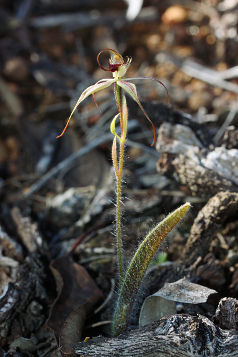
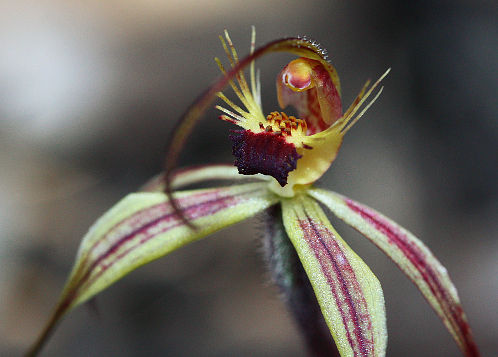
One of the Wheatbelt’s weirdest-looking Spider Orchids is the Dragon Orchid (Caladenia barbarossa). It features a broad, hairy labellum with a set of rather unusual decorations. The Dragon Orchid is common and widespread along the western edge of the Wheatbelt where it grows in winter-wet situations such as granite outcrops, Sheoak thickets and the margins of seasonal swamps and creeks. Due to its modest size and inconspicuous colour it is easily overlooked despite being locally common.
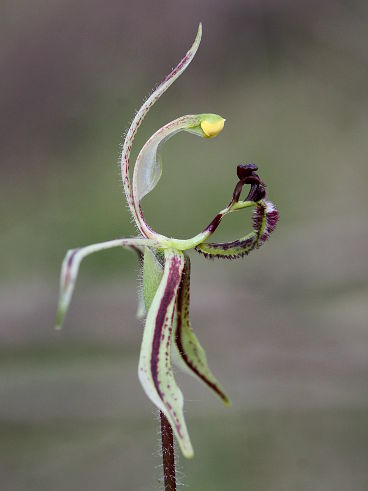
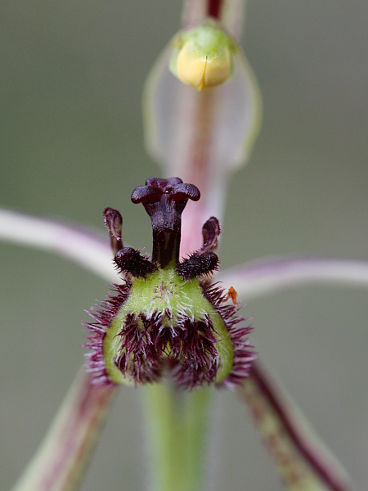
A few species of orchid are extremely abundant and can be found throughout almost the entire Wheatbelt region. These include the tiny Sugar Orchid (Ericksonella saccharata) which grows in a variety of habitats and can be seen flowering in large numbers after good winter rainfall. A particularly common and well-known species is the Cowslip Orchid (Caladenia flava) which is found across all of south-western Australia and tends to grow in large colonies of sometimes hundreds of individuals. One of its subspecies, the Brookton Highway Cowslip Orchid (Caladenia flava subsp. ‘late red’), is endemic to the southern Wheatbelt and flowers in mid-spring. Another common orchid is the Little Pink Fairy Orchid (Caladenia reptans) which grows in the woodlands of the western Wheatbelt and is usually abundant, often forming dense clumps consisting of ten or more individuals.
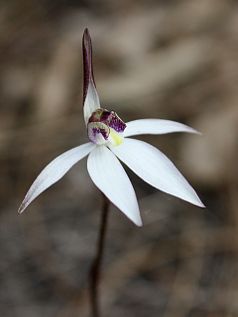
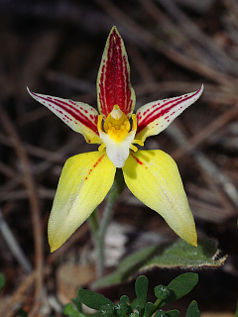
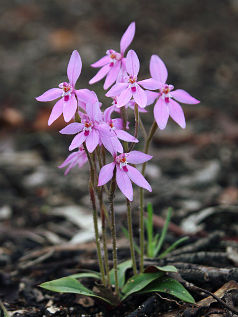
The Cowslip Orchid and the Little Pink Fairy Orchid are known to form spectacular hybrids which are renowned for their wide range of amazing colours, often combining various shades of yellow, orange, purple and red. These hybrids are most frequently encountered in winter-wet areas and around granite outcrops. Due to their ability to reproduce vegetatively, they typically grow in small colonies.
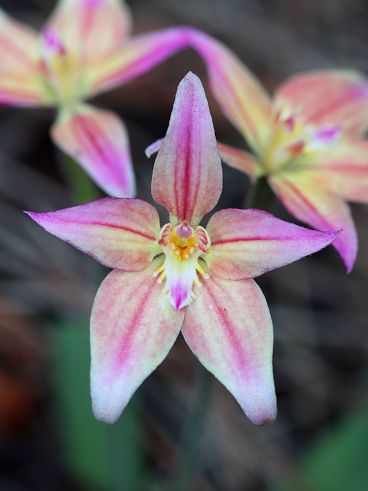
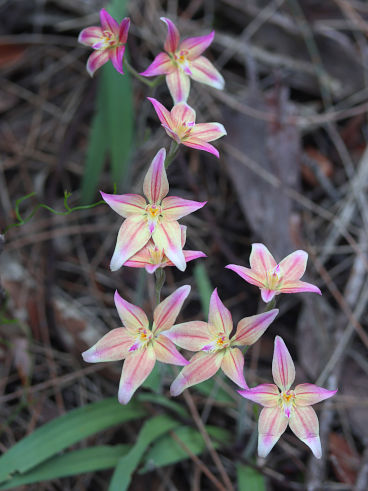
Donkey Orchids (Diuris), too, are among the most abundant orchids of the Wheatbelt. Their common name is derived from the two erect petals that resemble the ears of a donkey. There are numerous different species that all look alike and can only be told apart by an expert. Many Donkey Orchids have not even been scientifically described yet and thus don’t carry a proper scientific name. Among the more distinctive species is the Bee Orchid (Diuris laxiflora) which is found in seasonally wet areas across the western Wheatbelt. Other common species include the Common Donkey Orchid (Diuris corymbosa), the Western Wheatbelt Donkey Orchid (Diuris brachyscapa) and the Granite Donkey Orchid (Diuris picta).
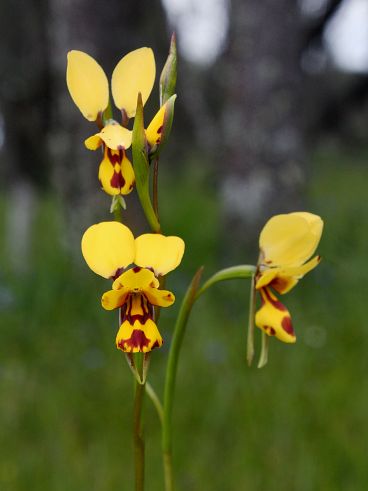
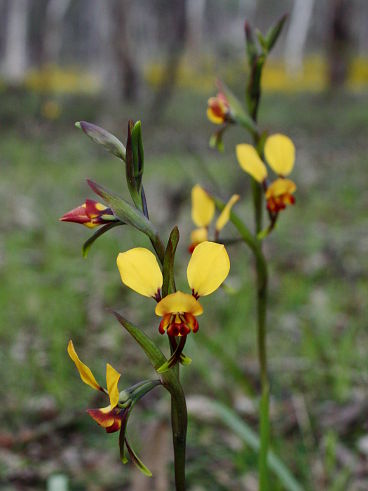
The Greenhood Orchids (Pterostylis) are somewhat less conspicuous than other orchids. A characteristic and common species is the Little Frog Greenhood (Pterostylis occulta) which can be found across the entire Wheatbelt and often thrives in fairly open and dry habitats where few other plants manage to survive. Among the more colourful Greenhoods are the Shell Orchids. The most common of these is the Red-veined Shell Orchid (Pterostylis hamiltonii) which is mostly found in Sheoak thickets around granite outcrops where there is extra moisture from rainwater runoff. Another unusually shaped species endemic to the Wheatbelt is the Dwarf Bird Orchid (Pterostylis galgula) which owes its English name to the vague resemblance of its green flowers to the silhouette of a bird. It too can be found across most of the Wheatbelt region.
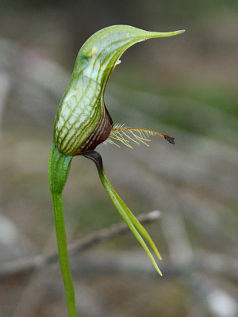
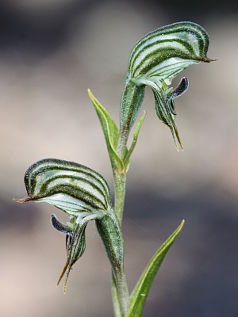
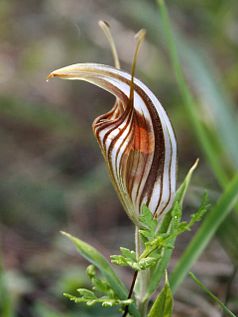
Among the Wheatbelt’s most handsome orchids are the Sun Orchids (Thelymitra). The most common and widespread species are the Granite Sun Orchid (Thelymitra petrophila) and the Lemon-scented Sun Orchid (Thelymitra antennifera), also known as the Vanilla Orchid because of its yellow flowers. Both species are common and widespread across most of the Wheatbelt and are usually found growing in soil pockets on and around granite outcrops where they receive extra moisture from rainwater runoff.
The magnificent Wandoo Sun Orchid (Thelymitra latiloba) is restricted to the south-western Wheatbelt where it grows in dry Wandoo woodland, often in deep bark and leaf litter. It is recognised by its striped flowers and unique column shape. The handsome Custard Orchid (Thelymitra villosa) is also found across the western parts of the Wheatbelt, but prefers slightly moister habitats such as winter-wet flats. It is one of the tallest and largest-flowered species of Sun Orchid and easily recognised by its yellow flowers with characteristic brown blotches. The Leopard Orchid (Thelymitra benthamiana) also prefers winter-wet habitats such as low-lying flats and the edges of seasonal rivers and swamps. It is generally widespread across south-western and south-eastern Australia.
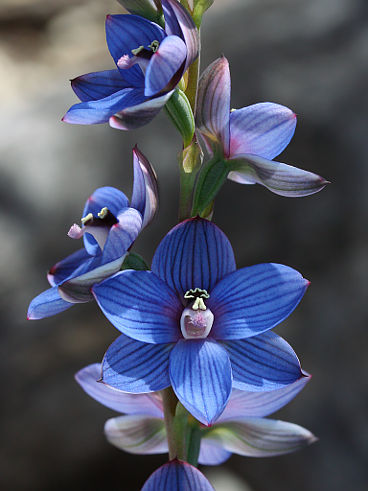
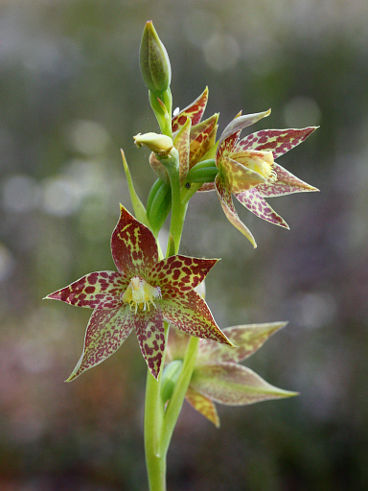
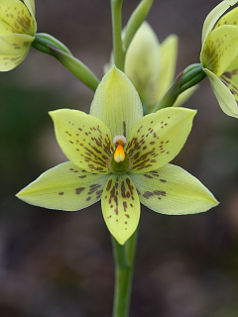
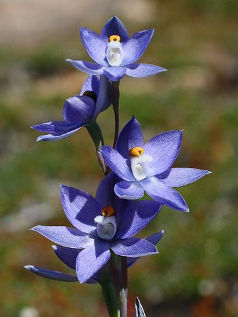
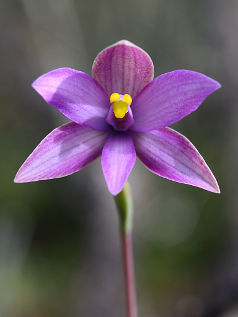
Reptiles
The Wheatbelt is home to a large number of different reptile species that thrive in the hot, semi-arid conditions. A common species is the Ornate Dragon (Ctenophorus ornatus) which lives on granite rocks where it is perfectly camouflaged thanks to its marbled pattern and brownish colour. When disturbed, Ornate Dragons will often run away at an astonishing speed on just their hind legs to seek shelter in holes and cracks in the rock. Another frequently encountered species is the Crested Dragon (Ctenophorus cristatus) which occurs in the semi-arid woodlands of the central and eastern Wheatbelt.
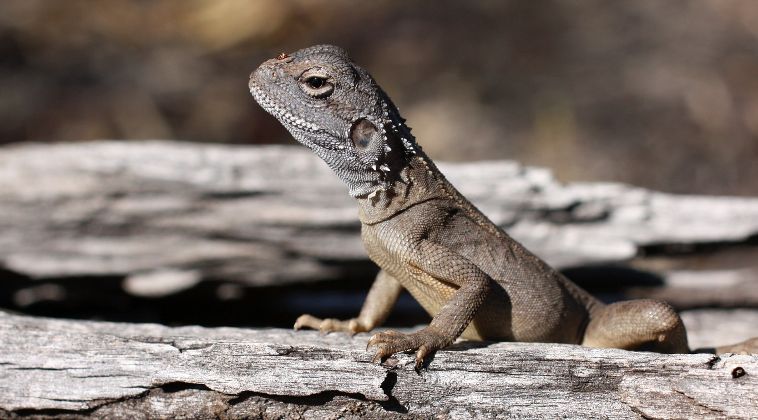
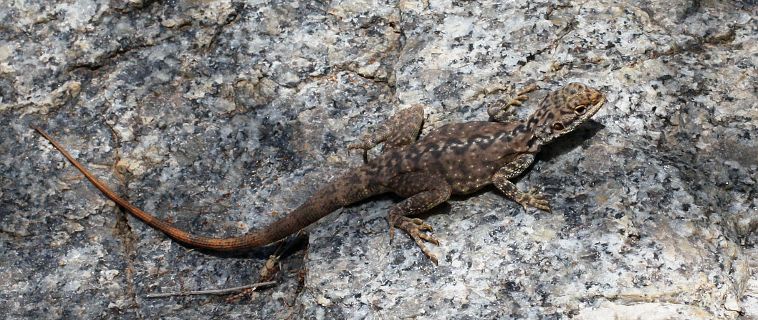
Wildflowers
Each year the Wheatbelt turns into a sea of colour when millions of wildflowers appear in late winter and early spring after good winter rainfall. Among the most colourful wildflowers are numerous species of Everlastings, also known as Strawflowers. Their common English name is a reference to their ability to retain their shape and colour after being cut and dried, making them popular among horticulturalists. Everlastings often cover the ground in their millions and come in different colours, including white, orange, yellow and various shades of pink and purple.
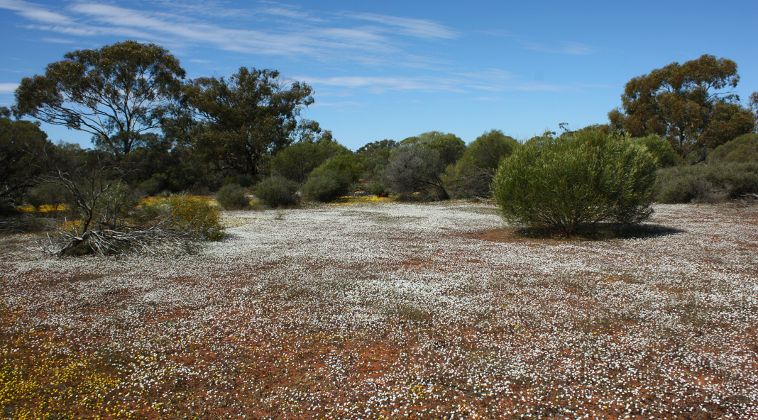
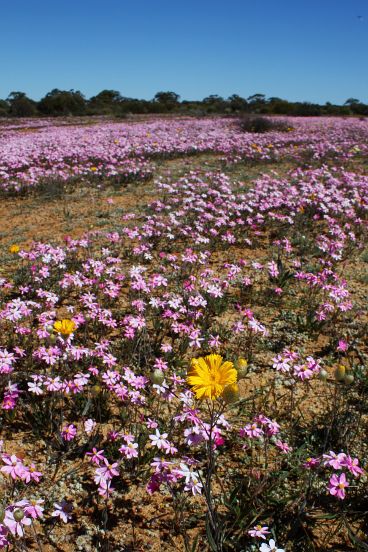
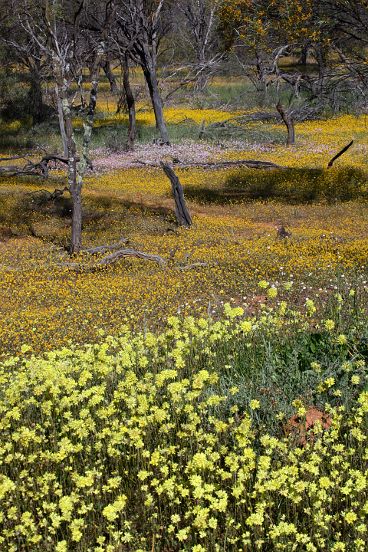
Among the most common species of Everlastings encountered throughout the Wheatbelt are the pink-flowered Mangles’ Everlasting (Rhodanthe manglesii) and the small-flowered Orange Immortelle (Waitzia acuminata). Both are known for their ability to form dense carpets of flowers that can cover large areas of native woodland.
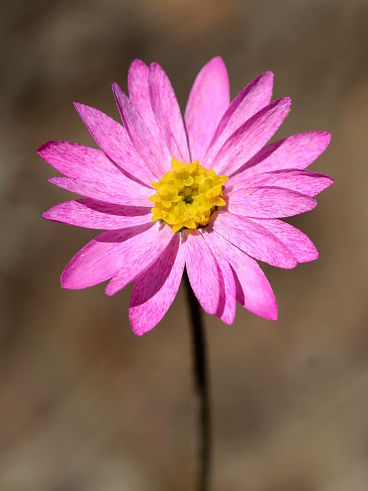
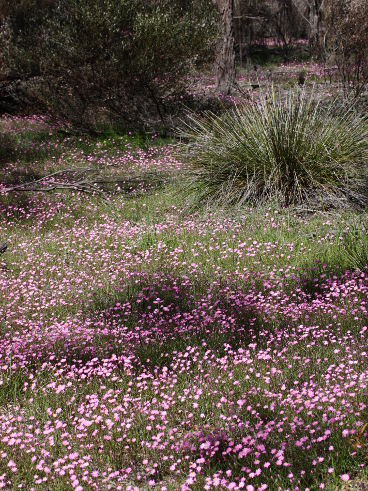
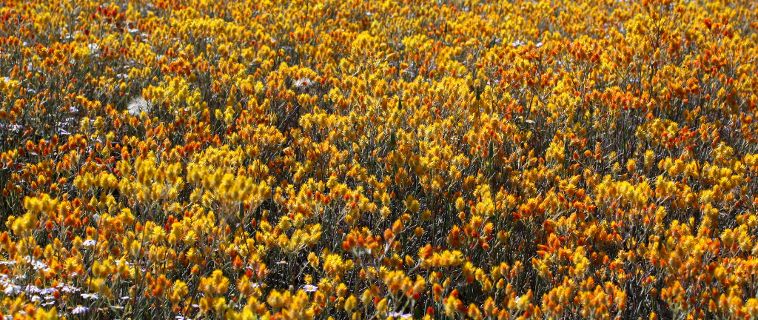
Not all of the Wheatbelt’s colourful flowers are native, though. A frequently encountered invasive weed is Paterson’s Curse (Echium plantagineum). Originally from southern Europe, this purple-flowered weed is capable of rapidly spreading across large areas of native bushland and, due to its toxicity, poses a threat to livestock.
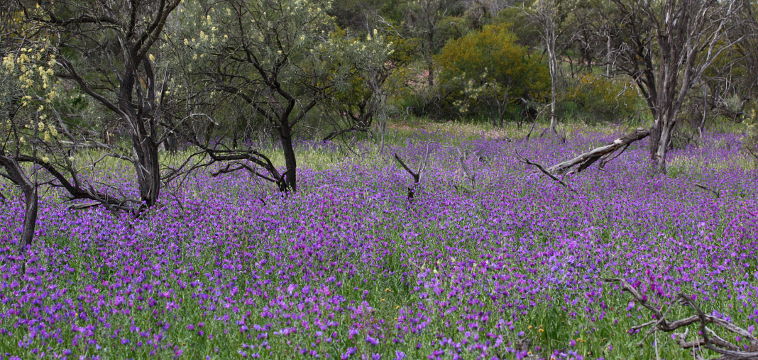
One of the most famous and spectacular native wildflowers of Western Australia is the aptly named Wreath Flower (Lechenaultia macrantha). Its pale-yellow and pink flowers form a neat, circular ring along the perimeter of the plant, giving it the appearance of a floral wreath. As Wreath Flowers prefer open, disturbed areas, they are most frequently seen along road verges in the northern parts of the Wheatbelt.
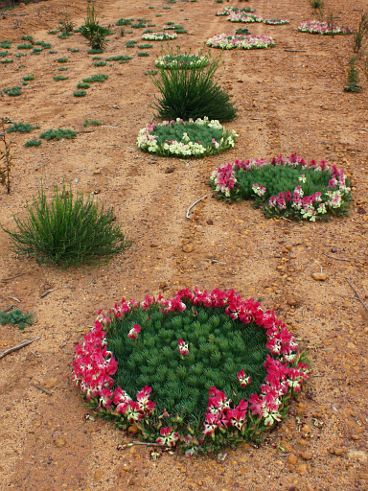
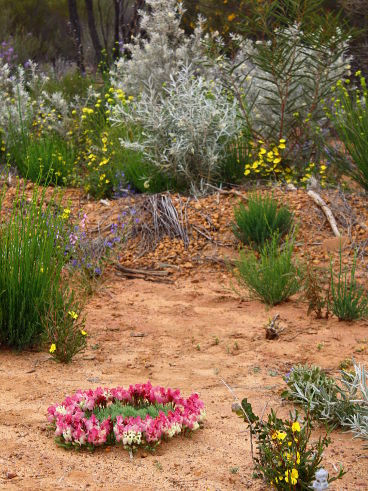
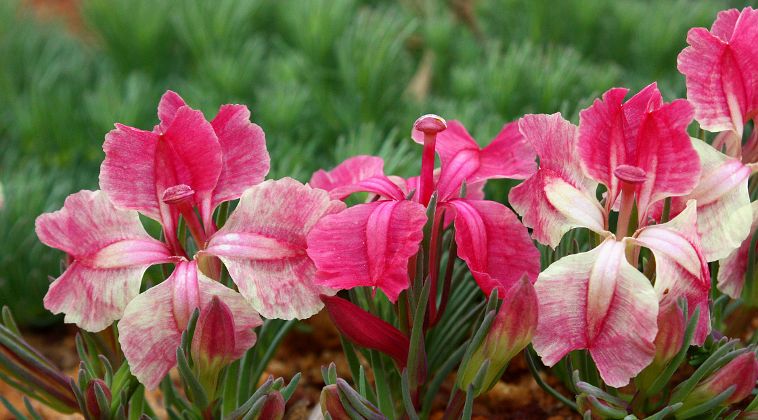
Another spectacular species from the same genus is the Red Leschenaultia (Lechenaultia formosa) which is widespread across the Wheatbelt. While not growing in the form of symmetric wreaths, its bright-red flowers are nevertheless a spectacular sight.
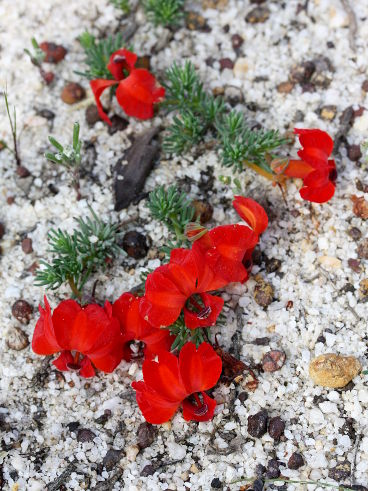
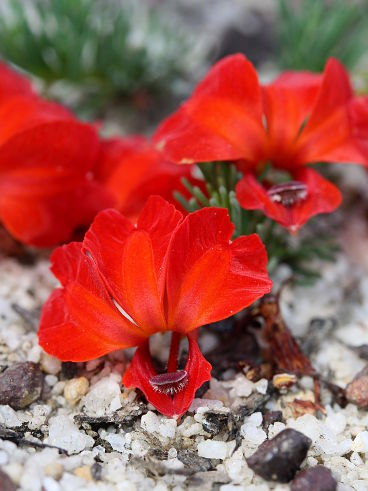
A characteristic species associated with granite outcrops is the Granite Kunzea (Kunzea pulchella) with its magnificent, glowing-red flowers. It can be found in soil pockets on granite rocks where it benefits from the additional moisture supplied by rainwater runoff. Another typical group of wildflowers found across the Wheatbelt are the Mulla Mullas (Ptilotus) with their characteristic, feathery flowers. One of the most common and widespread species is the Pussy Tails (Ptilotus spathulatus) which can be found in the more arid regions of the central and eastern Wheatbelt and is notable for its ability to thrive in otherwise dry and barren places.
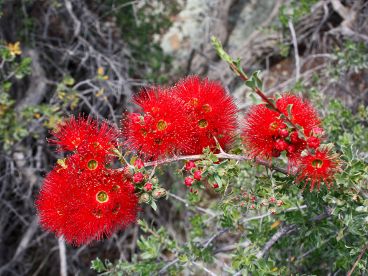
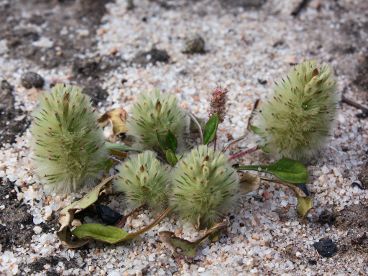
Among the most handsome wildflowers of the Wheatbelt are undoubtedly the Featherflowers (Verticordia) and Starflowers (Calytrix), both of which belong to the Myrtle family (Myrtaceae). They come in a wide range of spectacular colours and often grow in large colonies. Among the most common and widespread species are the yellow-flowered Verticordia acerosa and the purple-flowered Calytrix leschenaultii which grow in moist places such as winter-wet depressions and along the edges of seasonal creeks. They are an absolute delight to see, in particular when both species grow together in the same location and complement each other.
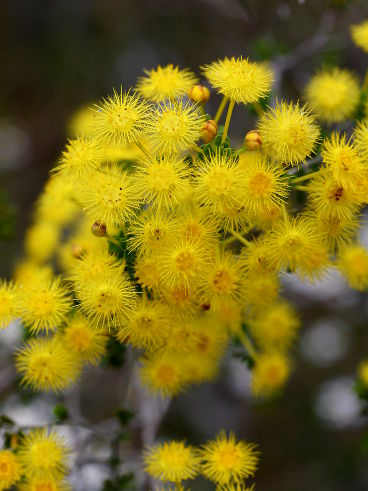
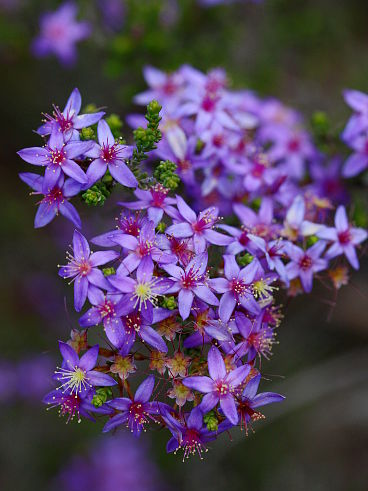
A small selection of photos showcasing the infinite variety of shapes and colours of the Wheatbelt’s many wildflower species is shown below. Among the most notable genera are the glowing Wattles (Acacia) which are mostly endemic to Australia, the highly variable and strange-looking Hakeas (Hakea) and the handsome Fringe Lilies (Thysanotus) with a large number of look-alike species that only an expert can tell apart.
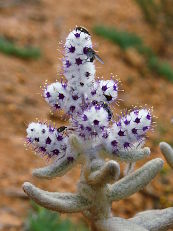
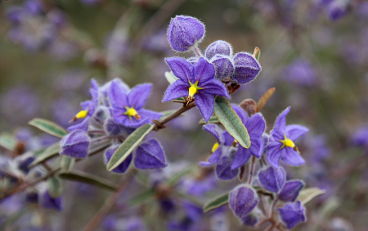
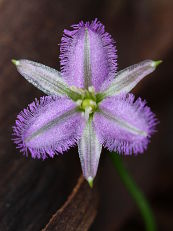
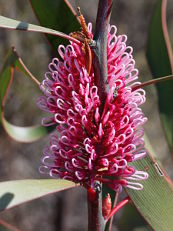
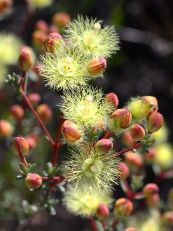
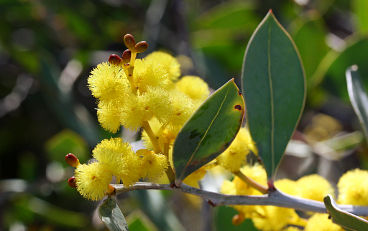
Butterflies and moths
As a result of the hot and dry climate, very few butterfly species call the Wheatbelt home. One of the more common and widespread species is the Western Xenica (Geitoneura minyas) which is endemic to south-western Australia and flies in just one generation annually during springtime. Other species that can be encountered throughout the Wheatbelt include the Meadow Argus (Junonia villida), which is common and widespread across Australia, and the Sciron Ochre (Trapezites sciron), which is found in south-western WA and parts of South Australia and Victoria.
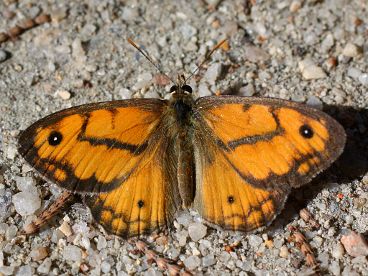
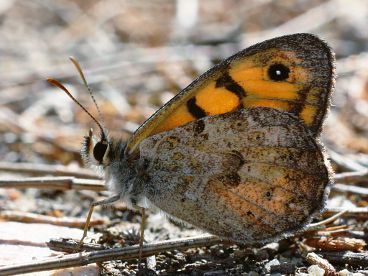
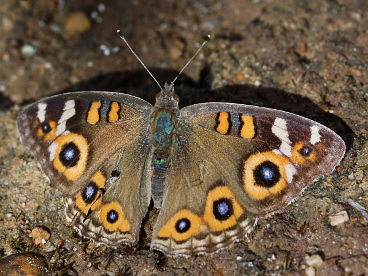
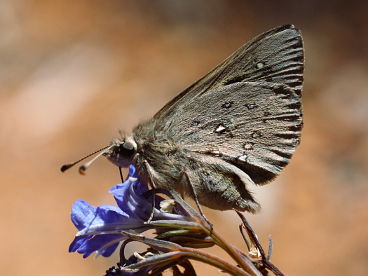
One of the rarest butterflies found in the Wheatbelt is the Large Bronze Azure (Ogyris idmo) which is endemic to south-western Australia. One of the reasons for its rarity is the fact that the caterpillars develop inside the nest of the ant species Camponotus terebrans. Hence the butterflies can only occur in places where the host ant is established. As a result, the Large Bronze Azure is known from only a few scattered populations in pockets of remnant woodland and shrubland across south-western Australia.
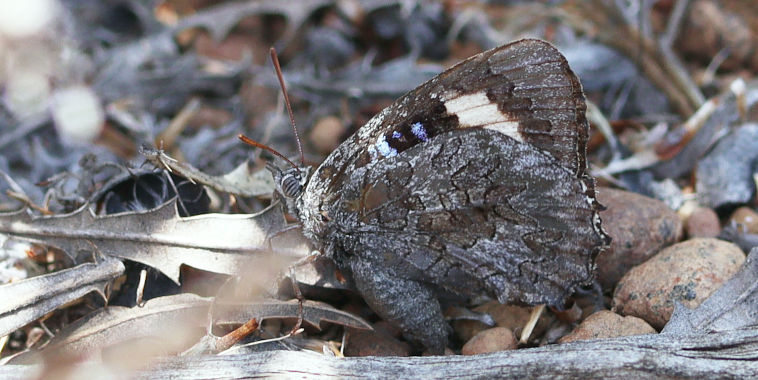
Among the most unusual insects of the Wheatbelt are the Sun Moths (family Castniidae). They could easily be mistaken for butterflies, as they are active on warm and sunny days, feed from flowers, spread out their wings when at rest and have clubbed antennae, just like a butterfly. They are, however, generally classified as moths, even though they were at times placed within the butterflies by some authors. At least two dozen species of Sun Moth are currently known to occur across south-western WA. As many of them look very similar, they are generally difficult to tell apart, and most species have not even been formally described yet.
